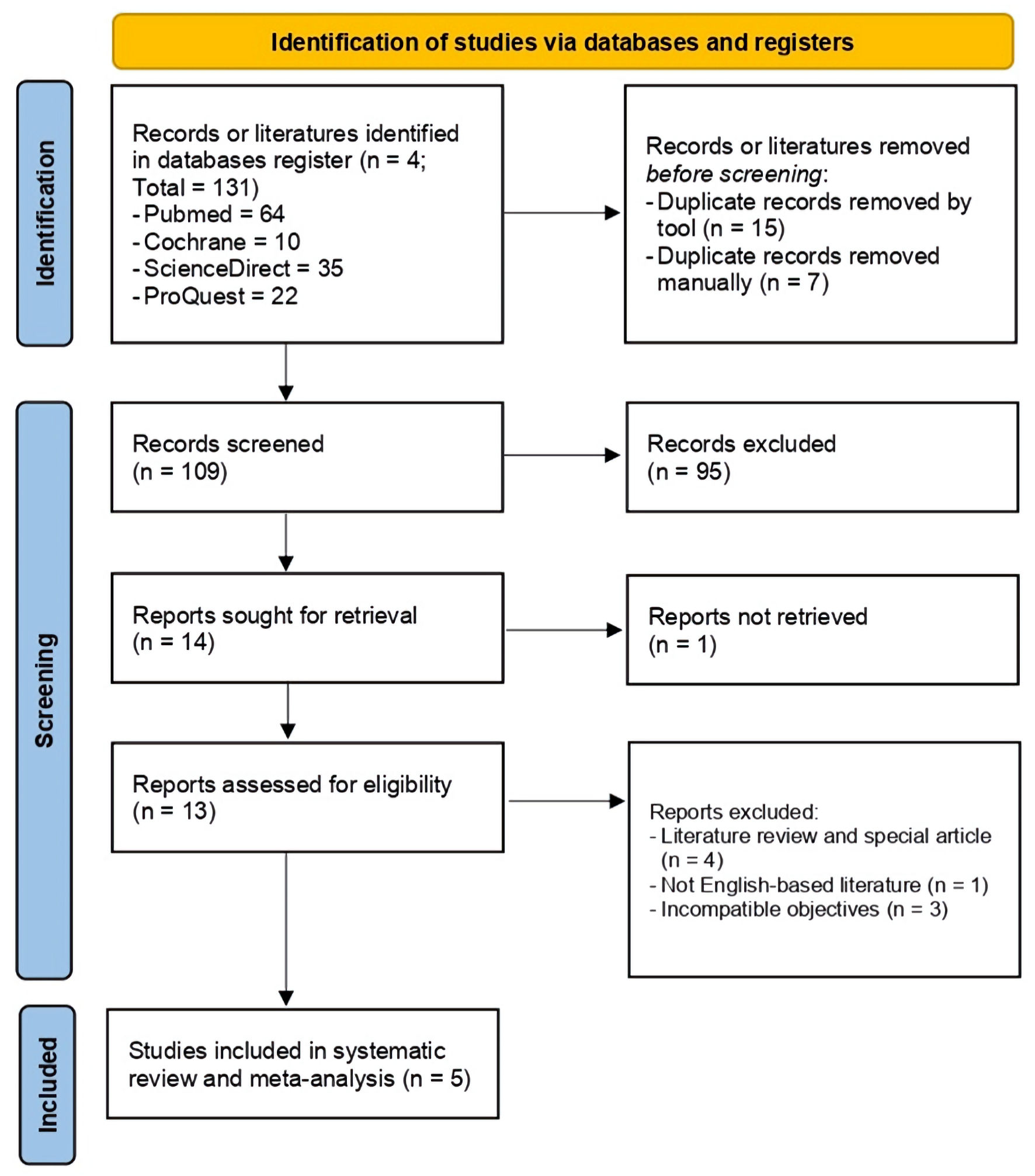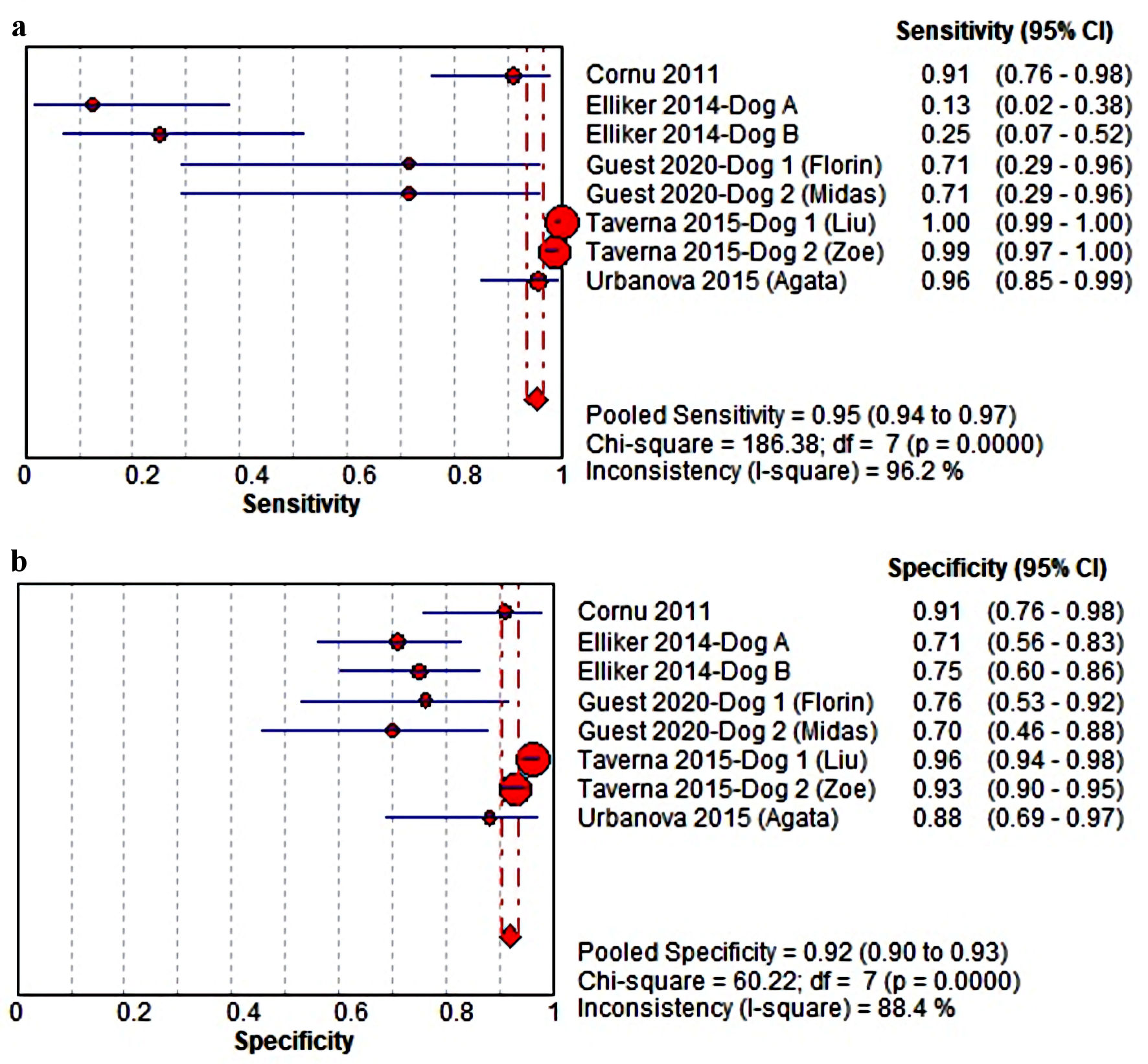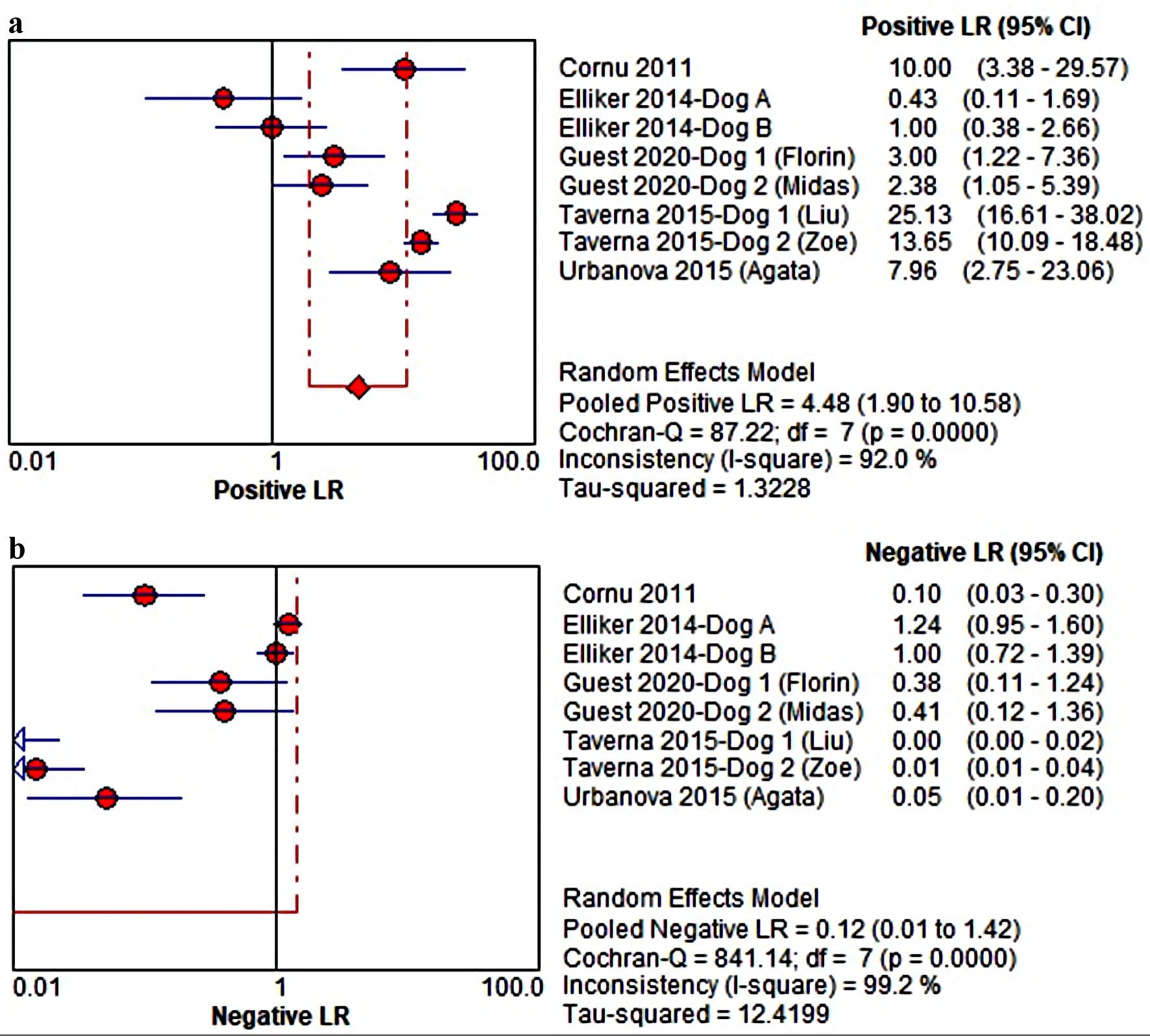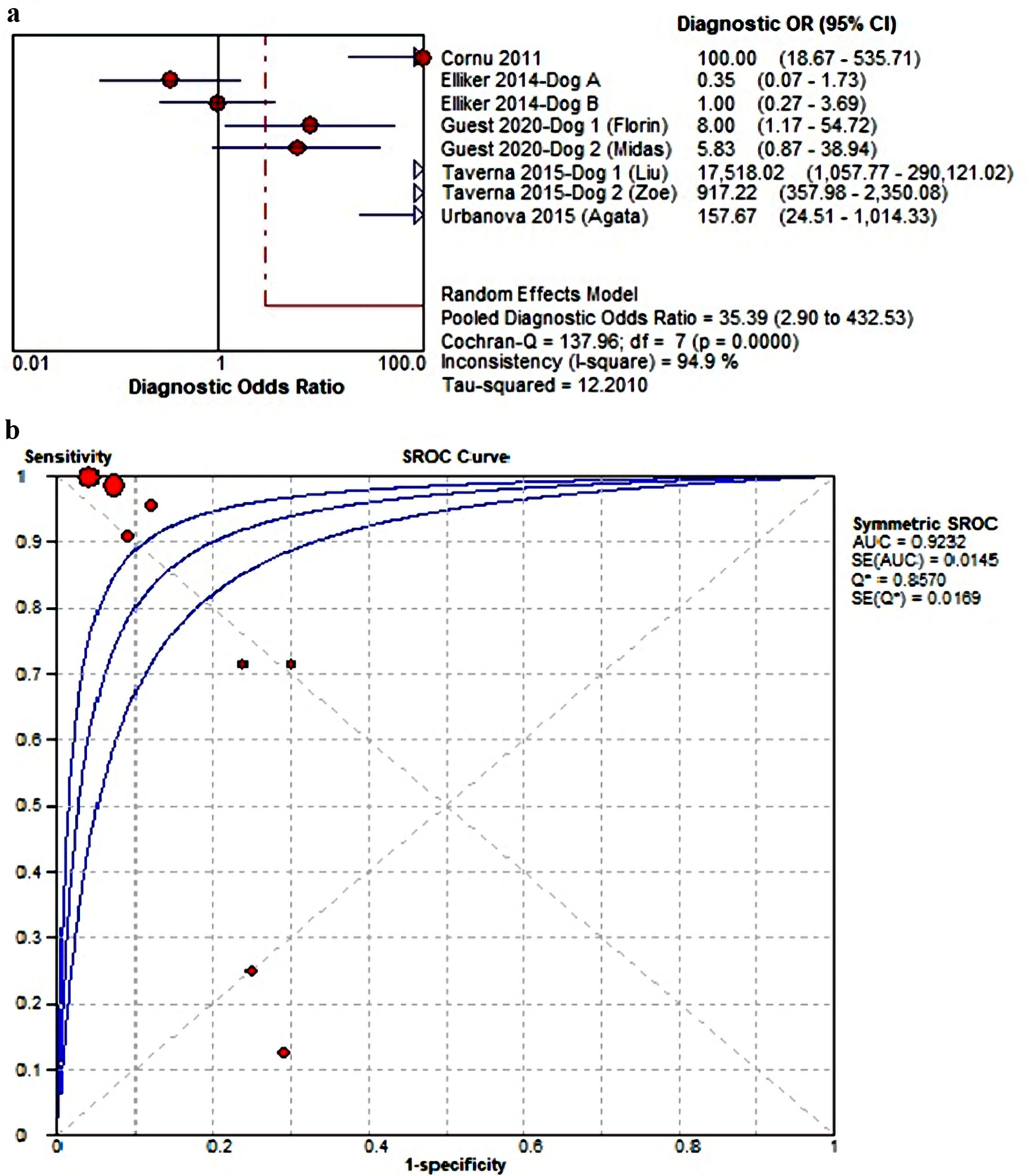
Figure 1. PRISMA flow diagram used to identify the included literatures. PRISMA: Preferred Reporting Items for Systematic Reviews and Meta-Analysis.
| World Journal of Oncology, ISSN 1920-4531 print, 1920-454X online, Open Access |
| Article copyright, the authors; Journal compilation copyright, World J Oncol and Elmer Press Inc |
| Journal website https://www.wjon.org |
Original Article
Volume 14, Number 5, October 2023, pages 358-370
The Olfaction Ability of Medical Detection Canine to Detect Prostate Cancer From Urine Samples: Progress Captured in Systematic Review and Meta-Analysis
Figures




Tables
| Study | Dog training phase | Patient and sample (testing phase) | |||||||
|---|---|---|---|---|---|---|---|---|---|
| Breed, gender, dog’s name, and age at the start of training | Trainer and prior training status | Program (rewarding) | Training phase count, session duration, period and in-training blinding status | Urine sample type and size (for training phase; PCA/control) | Sample size (% of Gleason ≥ 8 for PCa or % of female for control) and age (years) | PSA level (ng/mL) | |||
| PCa | Control | PCa | Control | ||||||
| F: female; MDD: medical detection dog; NR: not reported; PCa: prostate cancer; PSA: prostate-specific antigen. | |||||||||
| Cornu et al, 2011 [20] | Belgian Malinois; NR | A professional trainer + two assistants (none) | Clicker training (ball if accurate) | 5 day/week, from October 2007 to June 2010 (± 16 months); double-blind | Undiluted urine of PCa and healthy individual (unblinded) | 33 (12.1); 64.1 ± 7.1 | 33 (-); 63.2 ± 7.1 | 11.7 ± 15.1 | 8.3 ± 4.1 |
| Elliker et al, 2014 [21] | Labrador (dog-A); 9-year-old | Multiple professional trainers + behavioral scientist (none) | Clicker training (food if accurate) | Two phases (familiarization and consolidation), trained for 5 months (dog-A) and 8 months (dog-B); double-blind | Urine of PCa and healthy individual | 15 (0.0); 63.6 ± 6.4 | 45 (-); 57.7 ± 5.2 | 7.2 ± 4.6 | < 0.5 |
| Border Collie (dog-B); 3-year-old | |||||||||
| Guest et al, 2021 [22] | Female Labrador (Florin); 4-year-old | The dogs had been trained by MDD, UK and at a university hospital for ± 3 years | Unspecified rewarding training | 22 training days for NR duration in each session from November 2015 to September 2018 (± 35 monthes); double-blind | Undiluted urine of PCa and healthy individual | 7 (100.0); 65.5 (49 - 75) | 20; 68.5 (45 - 80) | 8.0 (3 - 76) | 4.7 (1 - 18) |
| Female Wire Haired Hungarian Viszla (Midas); 7-year-old | 21; 68.5 (45 - 80) | ||||||||
| Taverna et al, 2015 [19] | Female German Shepherd (Liu); 3-year-old | A veterinary surgeon, a professional trainer, and two assistants (none) | Clicker training (NR rewarding) | Four phases (each phase progress to more diluted control urine, from 50% (phase 1) to undiluted (phase 4); June 2012 to October 2012 (4 moths); double-blind | Undiluted urine of PCa patients (200) and healthy individual (230) | 362 (16.6) | 540 (18.8% F) | 120 (33.1%) patients had PSA level > 2.5 | 418 (77.4%) patients had PSA level < 1.0 |
| Female German Shepherd (Zoe); 3-year-old | |||||||||
| Urbanova et al, 2015 [18] | Female German Shepherd (Agata Jankari); 7-month-old | A group of trainers (prior basic obedience and scent work training) | Clicker training (treat if accurate) | Two phases (familiarization and consolidation), 4 - 5/session/week for 11 months; single-blind | Urine of PCa and healthy individual | 45 | 25 | NR | |
| Study | Risk of bias | Applicability concerns | |||||
|---|---|---|---|---|---|---|---|
| Patient selection | Index test | Reference standard | Flow and timing | Patient selection | Index test | Reference standard | |
| Cornu et al, 2011 [20] | Low-risk of bias | Low-risk of bias | Low-risk of bias | Unclear-risk of bias | Low-risk of bias | Low-risk of bias | Low-risk of bias |
| Elliker et al, 2014 [21] | Low-risk of bias | Low-risk of bias | Unclear-risk of bias | Low-risk of bias | Low-risk of bias | Low-risk of bias | Unclear-risk of bias |
| Guest et al, 2021 [22] | Low-risk of bias | Low-risk of bias | Low-risk of bias | High-risk of bias | Low-risk of bias | Low-risk of bias | Low-risk of bias |
| Taverna et al, 2015 [19] | Low-risk of bias | Low-risk of bias | Unclear-risk of bias | Low-risk of bias | Low-risk of bias | Low-risk of bias | High-risk of bias |
| Urbanova et al, 2015 [18] | Low-risk of bias | Low-risk of bias | Unclear-risk of bias | Low-risk of bias | Low-risk of bias | Low-risk of bias | Low-risk of bias |